外研版高中英语必修三Module1
- 格式:doc
- 大小:147.00 KB
- 文档页数:3

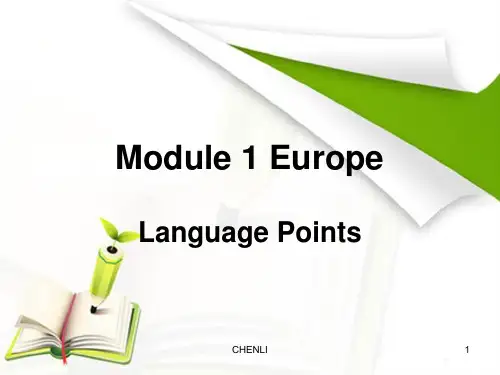
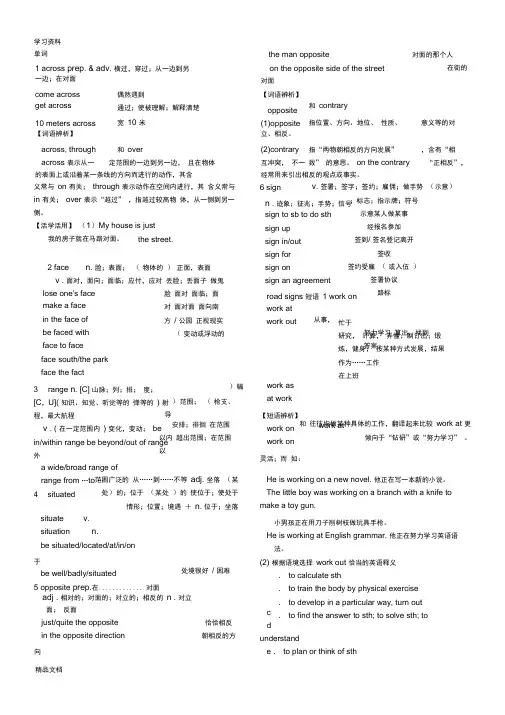
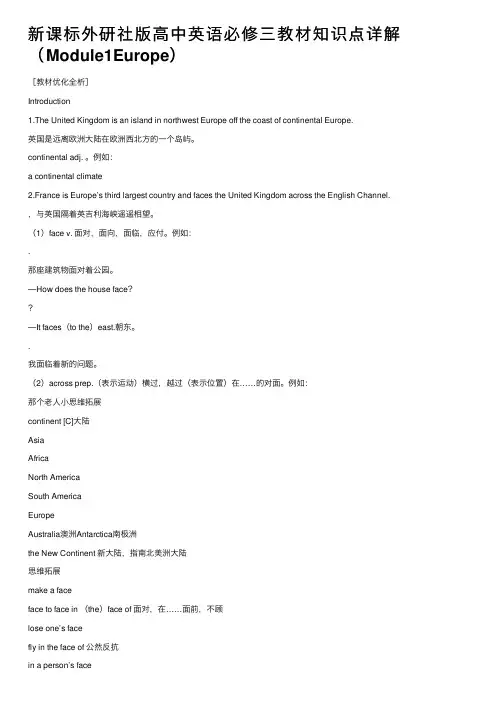
新课标外研社版⾼中英语必修三教材知识点详解(Module1Europe)[教材优化全析]Introduction1.The United Kingdom is an island in northwest Europe off the coast of continental Europe.英国是远离欧洲⼤陆在欧洲西北⽅的⼀个岛屿。
continental adj. 。
例如:a continental climate2.France is Europe’s third largest country and faces the United Kingdom across the English Channel.,与英国隔着英吉利海峡遥遥相望。
(1)face v. ⾯对,⾯向,⾯临,应付。
例如:.那座建筑物⾯对着公园。
—How does the house face?—It faces(to the)east.朝东。
.我⾯临着新的问题。
(2)across prep.(表⽰运动)横过,越过(表⽰位置)在……的对⾯。
例如:那个⽼⼈⼩思维拓展continent [C]⼤陆AsiaAfricaNorth AmericaSouth AmericaEuropeAustralia澳洲Antarctica南极洲the New Continent 新⼤陆,指南北美洲⼤陆思维拓展make a faceface to face in (the)face of ⾯对,在……⾯前,不顾lose one’s facefly in the face of 公然反抗in a person’s face⼼地越过马路。
He lives across the street from us.。
3.Italy is in the south of Europe on the coast of the Mediterranean Sea.意⼤利位于欧洲南部,地中海岸边。
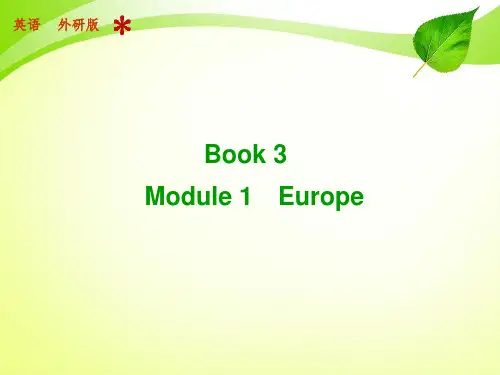
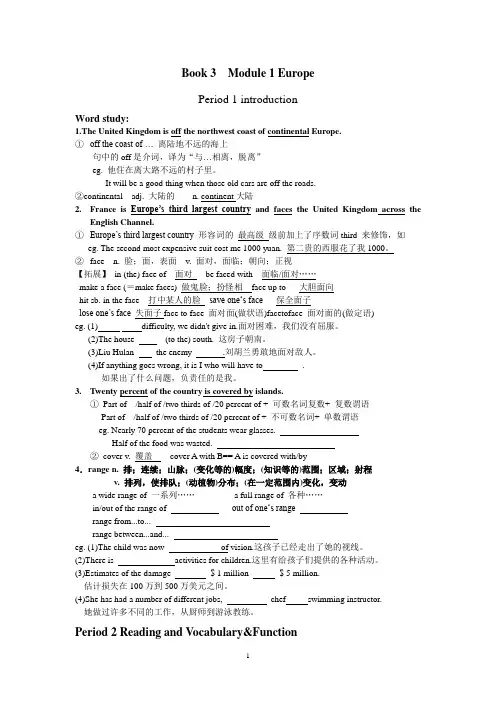
Book 3 Module 1 EuropePeriod 1 introductionWord study:1.The United Kingdom is off the northwest coast of continental Europe.①off the coast of … 离陆地不远的海上句中的off是介词,译为“与…相离,脱离”eg. 他住在离大路不远的村子里。
It will be a good thing when those old cars are off the roads.②continental adj. 大陆的n. continent大陆2.France is Europe’s third largest country and faces the United Kingdom across theEnglish Channel.①Europe‟s third largest country 形容词的最高级级前加上了序数词third 来修饰,如eg. The second most expensive suit cost me 1000 yuan. 第二贵的西服花了我1000。
②face n. 脸;面,表面v. 面对,面临;朝向;正视【拓展】in (the) face of 面对be faced with 面临/面对……make a face (=make faces) 做鬼脸;扮怪相face up to 大胆面向hit sb. in the face 打中某人的脸save one…s face 保全面子lose one‟s face失面子face to face 面对面(做状语)facetoface 面对面的(做定语)eg. (1)_____ ____ difficulty, we didn't give in.面对困难,我们没有屈服。
(2)The house (to the) south. 这房子朝南。
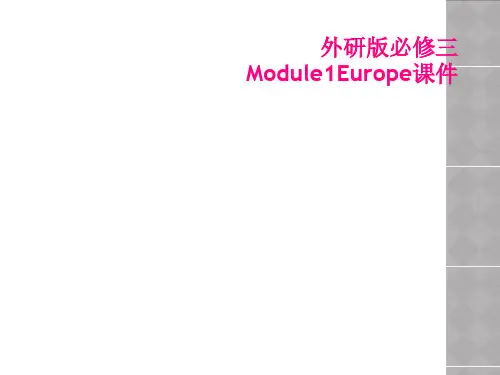
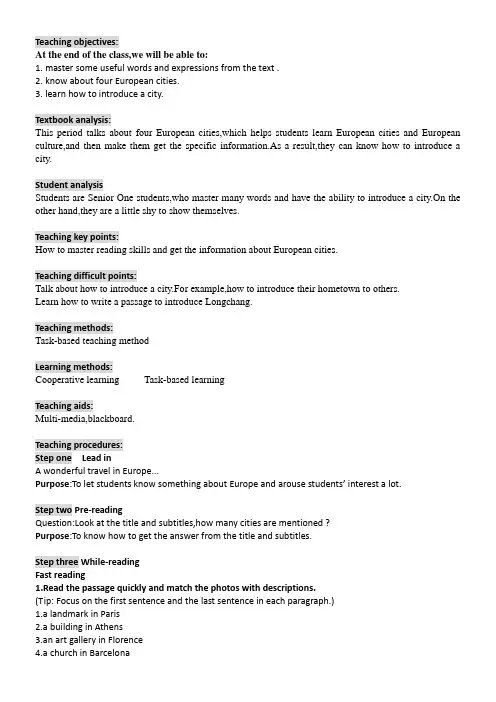
Teaching objectives:At the end of the class,we will be able to:1. master some useful words and expressions from the text .2. know about four European cities.3. learn how to introduce a city.Textbook analysis:This period talks about four European cities,which helps students learn European cities and European culture,and then make them get the specific information.As a result,they can know how to introduce a city.Student analysisStudents are Senior One students,who master many words and have the ability to introduce a city.On the other hand,they are a little shy to show themselves.Teaching key points:How to master reading skills and get the information about European cities.Teaching difficult points:Talk about how to introduce a city.For example,how to introduce their hometown to others.Learn how to write a passage to introduce Longchang.Teaching methods:Task-based teaching methodLearning methods:Cooperative learning Task-based learningTeaching aids:Multi-media,blackboard.Teaching procedures:Step one Lead inA wonderful travel in Europe...Purpose:To let students know something about Europe and arouse students’ interest a lot.Step two Pre-readingQuestion:Look at the title and subtitles,how many cities are mentioned ?Purpose:To know how to get the answer from the title and subtitles.Step three While-readingFast reading1.Read the passage quickly and match the photos with descriptions.(Tip: Focus on the first sentence and the last sentence in each paragraph.)1.a landmark in Paris2.a building in Athens3.an art gallery in Florence4.a church in BarcelonaPurpose:From the pictures,to let students know more details about European cities,and get the background information.2.Answer the questions.1. Which of the cities are capital cities?2. Which one is situated on the coast?3. Which is famous for its places to eat?4. Which ones are or were important cities for writers and artists?5. Which was the world’s greatest city a long time ago?Purpose:To learn reading skills better-focus on the first sentence and the last sentence in each paragraph.Careful readingFind out the specific information.(Tip: Pay attention to some key words and key sentences.)Purpose:To let students know to pay attention to some key words and key sentences.Step four Post-readingSummary.1.Fill in the blanks.Paris, Barcelona, Florence and Athens are four great 1.________ (Europe) cities.Paris, one of the most beautiful cities in the world, is the capital and 2.________ (large) city of France. It is famous3._______ the Eiffel Tower, its restaurants, cafes and theaters.The second largest city of Spain is Barcelona,One of the famous4._______(landmark) is the Church of the Sagrada Familia5._______(design) by Antonio Gaudi.Florence, 6._______ Italian city, became famous for the Renaissance 7._______ began in the 1300s and lasted for 300 years and is now visited by about a million tourists each other.Athens, the birthplace of western civilization, 8._______ (be) the capital of Greece. It used to be the world’s most 9.________ (power) city. The work of Greece’s best writers 10.________ (influence) other writers ever since.Purpose:To improve students’ reading skill about how to summarize the passage.2.Answer a question.Which of them would you most like to visit?And why?Purpose:To know the passage better and learn a lot about European cities.3.Discuss with partners.Imagine you were a guide and a visitor.Make a dialogue and introduce your hometown to partners.Here are some useful expressions as follows.introduce their hometown.And educate students love their country.Step five Tips on after class learnig.Introduce Longchang to your partners after class and then write a short passage about Longchang. Purpose:To master students’ writing skills and develop their interest in English.Purpose:To make students have a general idea of this class.Teaching evaluation and reflection:I should do everything I can to activate classroom atmosphere and arouse students’ interest in English.Also,since my teaching method is traditional,in the near future,I’d better change my teaching method into a new one,where not the teacher but students are the center.。
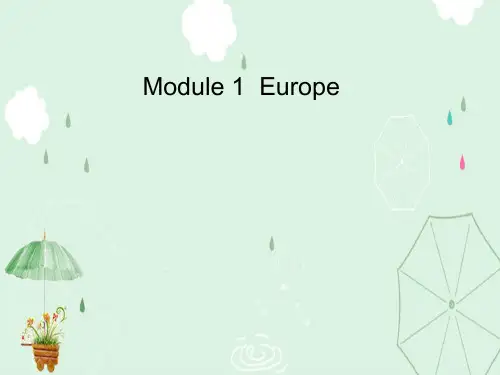
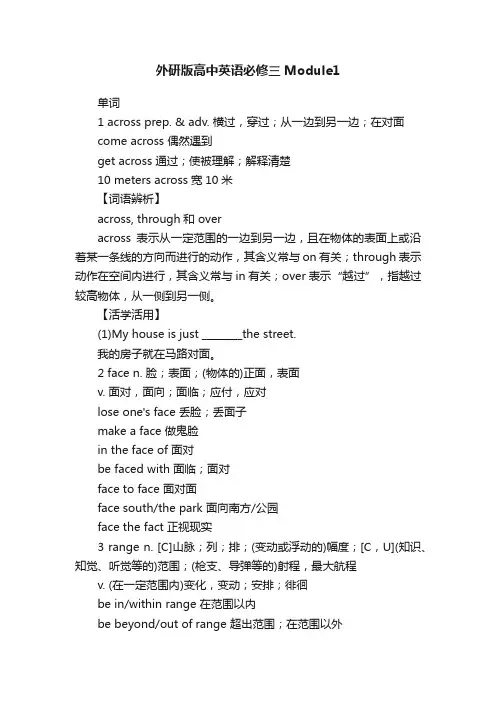
外研版高中英语必修三Module1单词1 across prep. & adv. 横过,穿过;从一边到另一边;在对面come across 偶然遇到get across 通过;使被理解;解释清楚10 meters across 宽10米【词语辨析】across, through和 overacross表示从一定范围的一边到另一边,且在物体的表面上或沿着某一条线的方向而进行的动作,其含义常与on 有关;through表示动作在空间内进行,其含义常与in有关;over表示“越过”,指越过较高物体,从一侧到另一侧。
【活学活用】(1)My house is just ________the street.我的房子就在马路对面。
2 face n. 脸;表面;(物体的)正面,表面v. 面对,面向;面临;应付,应对lose one's face 丢脸;丢面子make a face 做鬼脸in the face of 面对be faced with 面临;面对face to face 面对面face south/the park 面向南方/公园face the fact 正视现实3 range n. [C]山脉;列;排;(变动或浮动的)幅度;[C,U](知识、知觉、听觉等的)范围;(枪支、导弹等的)射程,最大航程v. (在一定范围内)变化,变动;安排;徘徊be in/within range 在范围以内be beyond/out of range 超出范围;在范围以外a wide/broad range of 范围广泛的range from…to…从……到……不等4 situated adj. 坐落(某处)的;位于(某处)的situate v. 使位于;使处于situation n. 情形;位置;境遇be situated/located/at/in/on+n. 位于;坐落于be well/badly/situated 处境很好/困难5 opposite prep. 在……对面adj. 相对的;对面的;对立的;相反的n. 对立面;反面just/quite the opposite 恰恰相反 in the opposite direction 朝相反的方向the man opposite 对面的那个人 on the opposite side of the street 在街的对面【词语辨析】opposite和contrary(1)opposite指位置、方向、地位、性质、意义等的对立、相反。
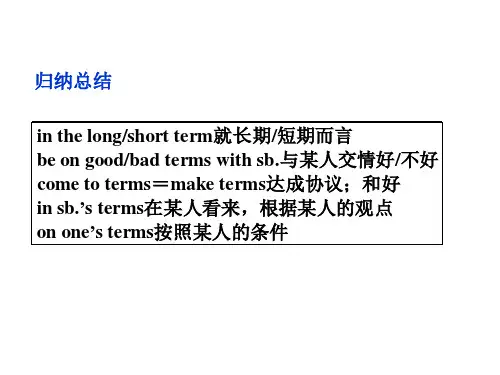
基础词汇+ 派生/ 重点短语收集整理、日常英语/ 重点句型/ 重点语法(被动、倒装、主谓一致)/ 章节重点内容(方位表达)单词派生:across-crossface-facialsituated-situationlocated-location-locatearchitect-architecturecivilization-civil-civilizesign-signatureagreement-agree-disagree-disagreementgovern-governor-governmentrepresentative-representgeographical-geographyproduce-produce-production单词:1•face n.脸vt. 面向/朝向/正视/面对be faced with…face to…facebookIn the face of …面对(问题,困难,危险)Lose face 丢脸,丢面Make a face/ make faces 扮鬼脸Pull a face 板着脸Face to face 面对面Faced with these pressures, what should we do? 面对这些压力,我们应该怎么办?Facing the complicated situation, he took everything coolly. 面对复杂的形势,他却淡然处之。
Faced with so much trouble, we failed to complete the task on time.Facing such a difficult problem, he didn't know what to do.The little girl’s round red face 小姑娘的红红的圆脸蛋The house faces north.We should face difficulties bravely.face up to…正视,勇敢的面对we never offer you another job, you’d better face up to it.2 •opposite adj./ prep./adv./n.Just opposite/Quite the opposite 恰好相反be opposite to…(…)在…对面,与..相反The lady sit just opposite me.(prep)We are opposite in character. 性格正好相反。
单词1 across prep. & adv. 横过,穿过;从一边到另一边;在对面come across 偶然遇到get across 通过;使被理解;解释清楚10 meters across 宽10米【词语辨析】across, through和 overacross表示从一定范围的一边到另一边,且在物体的表面上或沿着某一条线的方向而进行的动作,其含义常与on 有关;through表示动作在空间内进行,其含义常与in有关;over表示“越过”,指越过较高物体,从一侧到另一侧。
【活学活用】(1)My house is just ________the street.我的房子就在马路对面。
2 face n. 脸;表面;(物体的)正面,表面v. 面对,面向;面临;应付,应对lose one's face 丢脸;丢面子make a face 做鬼脸in the face of 面对be faced with 面临;面对face to face 面对面face south/the park 面向南方/公园face the fact 正视现实3 range n. [C]山脉;列;排;(变动或浮动的)幅度;[C,U](知识、知觉、听觉等的)范围;(枪支、导弹等的)射程,最大航程v. (在一定范围内)变化,变动;安排;徘徊be in/within range 在范围以内be beyond/out of range 超出范围;在范围以外a wide/broad range of 范围广泛的range from…to…从……到……不等4 situated adj. 坐落(某处)的;位于(某处)的situate v. 使位于;使处于 situation n. 情形;位置;境遇 be situated/located/at/in/on+n. 位于;坐落于be well/badly/situated 处境很好/困难5 opposite prep. 在……对面adj. 相对的;对面的;对立的;相反的n. 对立面;反面just/quite the opposite 恰恰相反 in the opposite direction 朝相反的方向the man opposite 对面的那个人 on the opposite side of the street 在街的对面【词语辨析】opposite和contrary(1)opposite指位置、方向、地位、性质、意义等的对立、相反。
(2)contrary指“两物朝相反的方向发展”,含有“相互冲突,不一致”的意思。
on the contrary“正相反”,经常用来引出相反的观点或事实。
6 sign v. 签署;签字;签约;雇佣;做手势(示意)n. 迹象;征兆;手势;信号;标志;指示牌;符号 sign to sb to do sth 示意某人做某事sign up 经报名参加sign in/out 签到/签名登记离开sign for 签收sign on 签约受雇(或入伍)sign an agreement 签署协议road signs 路标短语1 work on 从事,忙于work at 研究,努力学习work out 计算,算出,找到答案;弄懂;制订出;锻炼,健身;按某种方式发展,结果 work as 作为……工作at work 在上班【短语辨析】work on和work atwork on往往指做某种具体的工作,翻译起来比较灵活;而work at更倾向于“钻研”或“努力学习”。
如:He is working on a new novel.他正在写一本新的小说。
The little boy was working on a branch with a knife to make a toy gun.小男孩正在用刀子削树枝做玩具手枪。
He is working at English grammar.他正在努力学习英语语法。
(2)根据语境选择work out恰当的英语释义a.to calculate sthb.to train the body by physical exercisec.to develop in a particular way, turn out d.to find the answer to sth; to solve sth; to understande.to plan or think of sth12 have control over…对……加以控制bring/get/keep…under control 使……得到控制be in control of 控制;掌管be in the control of…受……控制be/get out of control 失去控制lose control of 失去对……的控制take/gain control over/of…取得/得到对……的控制under control/under the control of 在控制之下;得到控制【注意事项】control作不可数名词,表示“控制,支配,管理”,后接of 或 over。
【活学活用】(1)His son is being trained to ________________the family business.他儿子正在接受培训以掌管家族企业。
(2)Who's _______________the project?谁是这个项目的负责人?3.in terms of…就……而言;从……的观点;从……角度in any term 无论如何;在任何条件下 in the long term 长期内in the short term 短期内【活学活用】(1) Think of it ____________an investment.从投资的角度来考虑那件事。
(2)The house is ideal ____________size, but it is too expensive.从面积上看,这房子很理想,但价格太贵。
4 on the other hand 另一方面【用法点拨】on the other hand常和前面所讲内容进行对照,可以单独使用,也可以和on the one hand连用,表示“一方面,另一方面”,引导出不同的,尤其是相互矛盾的观点、意义等。
on the one hand…on the other (hand)一方面,另一方面for one thing…for another (thing)…首先……,其次……;一方面,另一方面句型Italy is in the south of Europe on the coast of the Mediterranean Sea. 意大利位于欧洲南部,濒临地中海。
be/lie【相关拓展】South of…be/lie………位于……的南部。
(属于倒装句句式,主谓一致要根据后面的名词来决定。
)【活学活用】(1)Spain is ___________________France.西班牙在法国南部。
(2)North of the town ______________________wheremany people like eating.在小镇的北边有两家有名的饭店,很多人喜欢在那里吃饭。
语法语法知识树:定义:表示主语为动作的承受者。
1.不清楚动作的执行者时2.没必要或不想指出1.被动语态用法:谁是动作的执行者时3.强调动作的承受者时构成:be+及物动词的过去分词语法一致2. 主谓一致意义一致就近原则语法讲解㈠被动语态1. 语态是动词的一种形式,用来表示主语和谓语之间的关系。
英语的语态分为主动语态和被动语态两种。
主动语态表示主语是动作的执行者;被动语态表示主语是动作的承受者。
只有及物动词或相当于及物动词的动词词组才有被动语态。
2. 被动语态的用法:⑴不清楚动作的执行者时,用被动语态,例如:He was wounded in the fight. 他在战斗在受伤了。
Electricity is used to run machines. 电是用来开动机器的。
⑵没必要或不想指出谁是动作的执行者时, 用被动语态,例如:Paper is made from wood. 纸是由木材生产出来的。
Do you know when the building was built ?你知道这座建筑物是什么时候建造的吗?2⑶强调动作的承受者时,用被动语态,例如:The window was broken by Tom.窗子是被汤姆打破的。
Books and newspapers in the reading room mustnt be taken away. 阅览室的书籍和报纸不准带走。
He was awarded first prize in that contest.他在比赛中获得了第一。
3.被动语态的构成: be+及物动词的过去分词。
被动语态发生时态变化时只变be的形式,过去分词不变。
4. 一般现在时的被动语态构成:am/is/are+及物动词的过去分词⑴ Our classroom ______ ______ every morning.我们的教室每天早上都要打扫。
(2)Paris _____ _____ by more than eight million tourists every year.每年有800多万观光者参观巴黎。
5.一般过去时的被动语态构成:was/were+及物动词的过去分词⑶ Li Ping _____ _____ for being late yesterday. 昨天李平由于迟到而受罚。
⑷This painting _____ ______ by him.这幅画是由他画的。
注意:短语动词转为被动语态时不可把动词后的介词丢掉。
例如:⑸You have to fill in this form.→This form has to be filled in.(介词in不可丢掉)⑹The old man takes care of his garden every day. →His garden _____ _____ ______ ______ every day by the old man.6.将主动语态变被动语态的基本方法为:⑴将主动语态的宾语作被动语态的主语;⑵谓语动词变为“be+及物动词的过去分词”,并通过be的变化来表达出不同的时态;⑶主动语态的主语变为介词by的宾语,组成介词短语放在被动结构中的谓语动词之后。